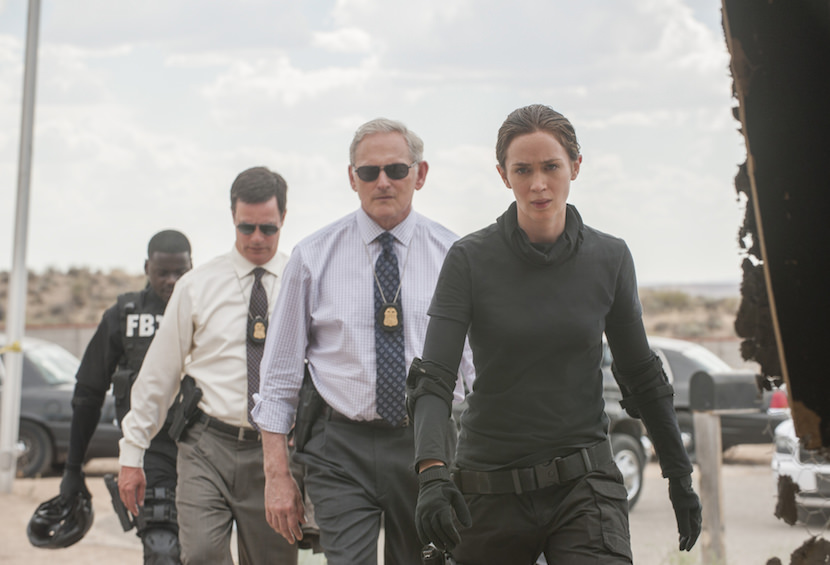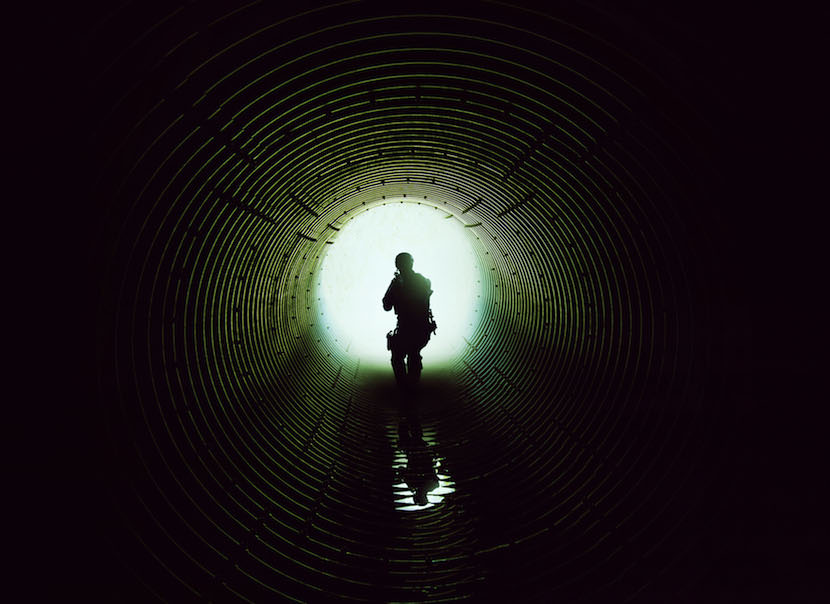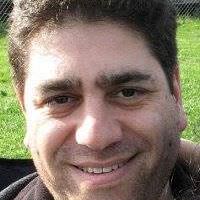Editor Joe Walker on Cutting the Brilliant Sicario
Joe Walker’s reputation has soared in recent years, from his work with director Michael Mann on the cyber thriller Blackhat (2014), and from his long collaboration with director Steve McQueen on McQueen’s loose trilogy of films dealing with suffering: Hunger (2008), Shame (2011), and 12 Years A Slave (2013), for which Walker received his first Oscar nomination for Best Editing. His work on Sicario is now theaters. It’s director Denis Villeneuve’s tense, violent, thriller about a U.S. SWAT team member (Emily Blunt) pulled into a moral quandary assisting a shady, inter-agency task force combatting vicious drug cartels on both sides of the Texas-Mexico border. We spoke to Walker about Sicario by phone from his editing suite in Montreal, where he’s at work cutting director Villenueve’s next film, Story of Your Life, a sci-fi movie starring Amy Adams.
What’s the first conversation like between Denis Villeneuve and you with regards to how you both see the picture?
We can go back further than that. This whole thing started because I had a conversation with my agent. We were at the 2014 Oscars [Walker was nominated for Best Editing on Steve McQueen’s 12 Years A Slave], and he said to me ‘What’s next?’ My daughter and I had just watched [Villenuve’s] Prisoners two nights before, and we both thought we were going have a heart attack, it was so tense, and I knew Incendies as well, I’m a big fan of that film. And I’m a huge fan of Paul Dano’s work, who had been in 12 Years and was in Prisoners as well. And I was talking to him about that, so it was on my mind about Denis. So I said to my agent ‘I’d really love to get in a room with Denis Villeneuve, but I think he’s got an editor he works with. But try and get me in that room.’ I got the script, and we met, our conversation was centered on the story, I think we were talking about the moral compass of the story which is really interesting to me. It was similar to Prisoners: how far are you prepared to go in terms of violence in order to solve a problem? How far to the dark side can one go for good reason? I was very taken with that idea. We talked a little bit about how I worked with Steve McQueen, that collaboration. Denis was a huge fan of those films. Luckily the job came my way and I was really grateful for it, especially as I heard that Denis wasn’t looking for anybody, he was set with his team.

You’ve worked with Steve McQueen [Hunger, Shame, 12 Years A Slave], and Michael Mann [Blackhat], and now Denis. They’re all directors who have a reputation for a strong, precise visual style. Does that present challenges to you in terms of the editing? What is that workflow like?
I was sending Denis assemblies as we went along, and we would talk sporadically every 3-4 days while he was shooting. Sometimes he would make a little suggestion or two. Also, he himself likes to cut while shooting, just so that can sleep at night! He likes to do it really crudely. I think he’d make a fantastic editor, but I’m glad he let’s me do that! What’s unusual about Sicario is it’s a very tight budget for the kind of film it is. I think it was under $30 million, which for this type of picture with a big location element, quite a bit of action, is very low, so they had to be super prepared, and super precise. Roger [Deakins, Cinematographer] and Denis discussed every shot, everything was carefully argued, in terms of what shot shot you need to tell which ‘beat’.
What arrived my way more than usually worked out. In a way it gave me a great luxury – of making [the footage] as muscular and rhythmic and precise as possible. Sometimes it was almost a matter of pride to show them another way. I don’t mean to be competitive, that’s an unusually competitive thought! But sometimes there was a little way that I could subvert their plan a bit, and tweak it in one way or another. It was really a perfect kind of edit, in terms of the time we had together, very quickly we worked it out, we think very similarly. I really loved his input, and I think he liked the way I cut it. So we concentrated on tweaking the performances and a little bit of streamlining. We did drop a few scenes, but there wasn’t much left on the cutting room floor.
In terms of Michael [Mann] and Steve [McQueen], it’s a much more experimental process. Sometimes Michael would shoot on three or four cameras, even on dialogue scenes, and he treats every shot as an individual shot, so when he gives notes on take 3, he’ll give notes for each individual camera, and they will all be different. It’s sometimes looking at three to four hours of material a day, with multiple editors, whereas Sicario was so paired down it was just me and my assistant Javier Marcheselli [during the shooting] and it was nice to keep control over everything. That was due to the fact that they only shot around an hour and half of footage a day.
Can you speak little about the editing of the action sequence on the bridge, in the middle of the picture?
A lot of what was going on in that sequence and its build up in editing terms was using the dialogue as almost a sound effect and as a rhythmic device. For example, there’s a lot of additional work on the audio, we recorded temp tracks of all sorts of voices through headphones, constantly keeping that sense that we’re hearing communications between all the vehicles, the helicopter pilot, and everything else. So you have the rhythmic level of the dialogue, and the other rhythm provided was a great moment he gave me, a shot of a dog barking, the camera pans from the back of the Tahoe [police vehicle] to a car and there’s a dog barking out the window. It arrives at just the right time when everything’s in place and you want to ratchet up the threat of violence, we used this dog barking. We also had Jóhann’s [Jóhannsson] music, which we manipulated in the cut a lot, he sent some drafts based on early scenes and we were able to edit that, build it into the sequence. We didn’t have temp [music] tracks, we had Jóhann’s music which was a real luxury.
The music score was incredible.
He did such a great job, when we first heard his music it was mind blowing. We sent him a very rough cut of the film, and he picked the helicopter sequence when the camera is following the police Tahoe SUV from El Paso Texas to Juarez, Mexico, through to the border crossing. He gave us that hugely distorted, ugly drumming sound, a falling base line, sort of lurching forward, an unsettling sound, and we just fell in love with it immediately. He sent us all sorts of material and it was definitely that one which was the most perverse, that we just instantly fell in love with.
Can you speak on the climatic action sequence when the team raids the drug tunnels. It’s very well thought out in terms of being able to follow where all the characters are, and in the dark!
They used genuine thermal cameras [to mimic what the Ops team is seeing with their night vision goggles], to try and avoid the Hollywood convention of seeing everything too clearly even though the characters are supposed to be seeing with night vision. And they set this in motion when the characters walk down the hill into blackness [leading to the tunnel]. That’s where me and Denis saw eye to eye, and my background with Steve [McQueen] means sometimes holding shots for a long time, for an unsettling amount of time, and that’s a real case in point, of holding a shot to the point where you think something’s going to come at you at any moment. The film had these repeated shocks, like in the beginning of the movie, cutting from a gory [severed] hand on the floor to Emily Blunt [washing blood off] in the shower. So right at the outset you’ve set up this expectation that when things get quiet something nasty could happen. We’re capitalizing on that tension-making device that’s settled in the film early. We did do some adjustments to the night sequence. Something we built a lot in the edit was the drone surveillance aspect, which was from post-production input. They had great helicopter footage, which brought a very contemporary take on things, the video game nature of a lot of warfare. It was discovery in the cut, when Benicio’s character near the end is entering the [drug kingpin’s] house, and we see him as just a dot from the drone footage, and a voice on the drone system says ‘We’re going blind.’ It’s got a dual meaning: we won’t see you when you go in the house, but also, we don’t want to see you when you’re in the house. We don’t want to know. And there’s something quite chilling about that being delivered from a drone point of view.

The final sequence between Benicio and Emily’s characters was played almost entirely in close-ups, in contrast to the many wide shots in the rest of the film.
My big discovery in life really was that when there is great tension in a performance, holding it invites the audience in, you get to read people’s faces and body language more. You’re not cutting and holding the audience’s hand and pointing up everything, but trying to make every cut count.



